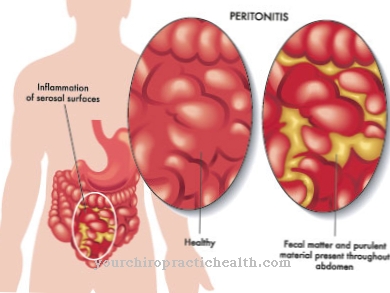The McCune-Albright Syndrome is a neurocutaneous syndrome that manifests itself as café-au-lait spots and disorders in bone metabolism. The cause of the hereditary disease is a genetic mutation in the GNAS1 gene, which codes for a regulator of cAMP. Treatment focuses on the administration of bisphosphonates.
What is McCune-Albright Syndrome?

© ustas - stock.adobe.com
The neurocutaneous syndromes are hereditary diseases, the main symptoms of which are neuroectodermal mesenchymal dysplasia. Classical phakomatoses belong to the group of diseases. Apart from these diseases, a number of syndromes belong to the group that manifest themselves dermally and simultaneously in the central nervous system. That too McCune-Albright Syndrome is a neurocutaneous syndrome.
This extremely rare disease is symptomatic of café-au-lait spots associated with disorders in bone metabolism. The American pediatrician Donovan James McCune and the endocrinologist Fuller Albright first described the disease in the 20th century. In the broadest sense, the Austrian pathologist Carl Sternberg is one of the first to describe the disease.
For this reason, the symptom complex is sometimes also from McCune-Albright-Sternberg Syndrome the speech. Further synonyms are the names Osteitis fibrosa cystica, Leontiasis ossea, Weil-Albright syndrome and Osteodystrophia fibrosa.
causes
The prevalence of McCune-Albright syndrome is given as between one to nine patients in 1,000,000 people. Girls are more often affected than boys. A familial cluster could be observed in the cases documented so far. So the syndrome doesn't seem to be sporadic. It is not yet known about the inheritance. The cause of McCune-Albright syndrome appears to be a genetic mutation.
A mutation in the GNAS1 gene was found in half of all patients. This gene codes for certain polypeptides in the DNA and is located on chromosome 20 in the gene locus 20q13.2. Among other things, the gene codes for the protein Gs-alpha, which is considered to be a cAMP-regulating protein. The genetic change results in a loss of function of the protein and thus results in a lack of regulation.
The change is a postzygotic mutation and for this reason can only be found in the form of a mosaic. The spontaneous mutation of the gene switches on the adenylyl cyclase and consequently increases the patient's cAMP level. These processes activate signal transduction mechanisms independent of the control system. An autonomous control loop is created.
Symptoms, ailments & signs
MAS patients show isolated symptoms or symptoms in multiple areas of the skeleton. A limp often occurs, which is accompanied by pain. Sometimes the disease also manifests itself in the form of pathological fractures. In many cases, the patients suffer from progressive scoliosis.
Vaginal bleeding occurs in women. The mammary glands develop unusually early. In men, there are sometimes enlarged testicles or penis that lead to sexual activity at an early age. These symptoms correspond to an endocrinopathy with hyperfunction.Endocrinopathies can also manifest as hyperthyroidism and be associated with the increased release of growth hormones.
In addition to symptoms of Cushing's syndrome, there is often a loss of phosphate via the kidneys. The syndrome usually manifests itself in the form of café-au-lait spots in newborns. Patients' skulls are often affected by abnormalities. The same can apply to the entire skeleton. A pseudopubertal praecox including acromegaly or short stature is particularly common. In some cases, those affected suffer from a progressive deterioration in vision and also develop malignancies as the disease progresses.
Diagnosis & course of disease
The respective extent of McCune-Albright syndrome depends on the proliferation, migration and viability of the mutated cells. The diagnosis is made by the doctor on the basis of clinical presentation. X-rays are often enough for a diagnosis. If in doubt, biopsies can be performed to confirm the diagnosis. When examining and diagnosing patients, specific tests take into account every organ that might be involved in MAS.
To date, no molecular analysis is available to confirm the diagnosis of the GNAS mutation. Nevertheless, genetic counseling is recommended. Neurofibromatoses, osteofibrous dysplasias and non-ossifying fibroids must be excluded during diagnosis. In the differential diagnosis, idiopathic central precocious puberty and ovarian neoplasia are also to be differentiated. Treatment and prognosis depend on the tissues affected and the severity of the involvement.
Complications
McCune-Albright syndrome causes a number of different complaints and symptoms in the patient. In most cases, this syndrome significantly restricts the person's movement and leads to a limp and further movement disorders. Many women also suffer from increased vaginal bleeding and pain as a result of the syndrome.
It is not uncommon for mood swings to occur, which in turn leads to a significantly reduced quality of life for the patient. The skin of those affected has brown spots, which have a very negative effect on the patient's aesthetics. This leads to decreased self-esteem and often a feeling of shame. Likewise, children can be teased or bullied because of the symptoms of McCune-Albright syndrome.
Furthermore, a short stature occurs and those affected suffer from visual problems, which can additionally limit everyday life. The individual complaints of McCune-Albright syndrome can be alleviated through various therapies. However, complete healing does not occur. Furthermore, the person concerned is also dependent on a high level of sun protection to protect the skin. Life expectancy is usually not affected by the disease.
When should you go to the doctor?
Any abnormalities in the skeletal system or mobility disorders should be presented to a doctor. A doctor is required if there are irregularities in the movements, restrictions in joint activity or an inconsistency in locomotion. Bad posture or tilted posture, pain when moving or a hunched posture of the body are signs of an existing health disorder. An examination is necessary so that a diagnosis and treatment can be made.
Women with McCune-Albright syndrome often experience involuntary vaginal bleeding. You should seek medical treatment. In addition, they should take special care so that no further complications arise in the planning of a possible reproduction. Affected boys and men show enlarged external sexual characteristics when they become ill. It is advisable to see a doctor so that the cause can be clarified and sexual dysfunction does not develop. If mental problems arise due to the visual changes in the testicles and penis, a doctor is also required.
A doctor should be consulted in the event of growth disorders, short stature or any other visual flaw. A change in the shape of the head is characteristic of McCune-Albright syndrome. If changes or abnormalities occur in the general appearance of the skin, the person concerned needs a doctor. Any spots or other discolouration of the skin should be presented to a doctor as they are an indication of an existing disease.
Therapy & Treatment
No causal therapy is currently available for patients with McCune-Albright syndrome. This means that the syndrome is still considered an incurable disease today. Causal therapy will only be available when gene therapy approaches reach the clinical phase. Treatment is mainly symptomatic and includes regular supportive controls. Consistent avoidance of UV exposure is recommended as a preventive measure in view of the malignancies that may occur.
The same applies to the consistent use of light stabilizers. In addition to these preventive steps, patients sometimes receive cosmetic treatment for their hyperpigmentation. The treatment of your fibrous dysplasia aims at stabilization. Conservative drug therapy can be used for this purpose. Bisphosphonates, for example, are often used.
The MAS-associated endocrinopathies may require surgical intervention. The same applies to malignancies. In most cases, patients are recommended to do additional strength exercises that strengthen the muscles in the immediate vicinity of the bones and thus reduce the general risk of fractures. The strength exercises usually take place under physiotherapeutic supervision. Depending on the respective organ involvement, the treatment steps mentioned can be supplemented by organ-specific treatment measures.
Outlook & forecast
McCune-Albright syndrome has an unfavorable prognosis. The disease is based on a genetic disposition. So far there is no therapy option that provides a cure for the health disorder. Scientists are not allowed to modify human genetics. As a result, no causal treatment can take place. The legal requirements mean that doctors concentrate on alleviating the existing symptoms during treatment.
Long-term therapy is necessary, since the termination of the initiated measures is associated with a relapse of the symptoms. Medicines are given so that enough bisphosphonates are available to the organism. In addition, the affected person's musculoskeletal system is supported with physiotherapeutic measures.
Regular check-ups are necessary in order to document changes in the complexion at an early stage. As soon as abnormalities appear, further treatment measures are necessary. If skin cancer develops, the patient is at risk of premature death.
The further development improves if the person concerned takes preventive measures. Sufficient protection from the effects of light is just as necessary as being able to carry out the physiotherapy exercise units on your own responsibility.
Due to the visual abnormalities of the disease as well as the impairment of the movement sequences, an increased risk of secondary diseases is to be expected with this disorder. For some of those affected, emotional stress in everyday life is so severe that psychological disorders can develop.
prevention
The McCune-Albright syndrome has so far not been successfully prevented because it is a genetically spontaneous mutation. At most, genetic counseling can be helpful in this context.
Aftercare
Because McCune-Albright syndrome treatment is relatively complex and lengthy, follow-up care focuses on managing the condition safely. Sufferers should try to focus on a positive healing process despite the adversity. In order to build up the appropriate posture, relaxation exercises and meditation can help calm and focus the mind, which has been irritated by the stress of the illness. Meditative exercises can have a positive effect on the strong mood swings. If depression or other psychological disorders have developed in the patient concerned or in the family environment, this should be discussed with a psychologist. Therapy can help restore mental balance and build a more positive attitude that makes it easier to deal with the disease. In this way, the quality of life can be increased despite the circumstances.
You can do that yourself
The individual symptoms of McCune-Albright syndrome can often be alleviated by those affected. However, the syndrome must first be clarified and treated by a doctor in order to rule out a severe course and serious complications.
Following diagnosis, it is important to maintain strict personal hygiene to avoid inflammation in the area of bleeding. Women who have vaginal bleeding should speak to their gynecologist. If growth disorders occur, the person affected or their parents should seek therapeutic help. Avoiding UV radiation is also important, as this can intensify individual symptoms and, under certain circumstances, cause long-term damage. Sunscreens and similar products should also be avoided or only used in consultation with the responsible doctor. In addition, a healthy lifestyle with a balanced diet, plenty of exercise and avoidance of stress is recommended. As a result and through preventive measures, serious consequences can be avoided in many cases.
If the self-help measures mentioned do not have any effect or new symptoms appear, the doctor must be consulted in any case. In addition to McCune-Albright syndrome, there may be another disease that needs to be clarified and, if necessary, treated.

.jpg)




.jpg)






.jpg)

.jpg)
.jpg)











.jpg)